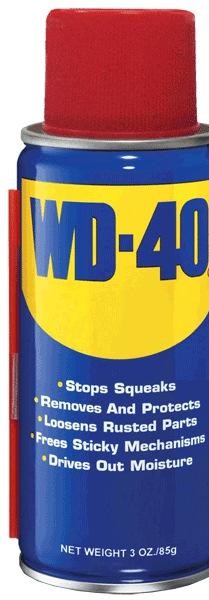By Terry Sovil from the September 2010 Edition
 There are only two tools any man needs. One is DUCT TAPE and the other is WD-40. If it moves and should not, use the duct tape. If doesn’t move, and should, use the WD-40. If neither of these works you have an electrical problem.
There are only two tools any man needs. One is DUCT TAPE and the other is WD-40. If it moves and should not, use the duct tape. If doesn’t move, and should, use the WD-40. If neither of these works you have an electrical problem.
An email arrived listing 46 things that WD-40 could do and it all looked too fantastic to be true. Never trust an email. Searching, oddly enough, produced the WD-40 website at http://www.wd40.com/uses-tips/
Think a list of 46 items is staggering? Their site lists 2000! To me WD-40 has always been a lubricant but their web site lists uses in this order: “WD-40, everyone’s favorite multi-purpose problem solver for over 50 years (1) cleans, (2) lubricates and (3) protects against corrosion.”
What is the main ingredient of WD-40? The email claims FISH OIL but the WD-40 website says: “While the ingredients in WD-40 are secret, we can tell you what WD-40 does NOT contain.” Fish Oil wasn’t on the “does not contain” list but it still “probably ain’t so”.
SCUBA dive manufacturers never recommend WD-40 due to claimed petroleum ingredients which are not good for breathing or rubber products.
What does WD-40 stand for? ‘Water Displacement #40’. The product began from a search for a rust preventative solvent and degreaser to protect missile parts. WD-40 was created in 1953 by three technicians at the San Diego Rocket Chemical Company. It first appeared on shelves in San Diego in 1958. They were successful with the fortieth formulation, thus WD-40.
WD-40 USES (NARROWED FROM 46):
1. Protects silver from tarnishing.
2. Removes road tar and grime from cars.
3. Cleans and lubricates guitar strings.
4. Gives floors that ‘just-waxed’ sheen without making them slippery.
5. Keeps flies off cows.
6. Removes lipstick stains.
7. Loosens stubborn zippers.
8. Untangles jewelry chains.
9. Removes stains from stainless steel sinks.
10. Removes dirt and grime from the barbecue grill.
11. Keeps ceramic/terra cotta garden pots from oxidizing.
12. Removes tomato stains from clothing.
13. Keeps glass shower doors free of water spots.
14. Camouflages scratches in ceramic and marble floors.
15. Keeps scissors working smoothly
16. Lubricates noisy door hinges on vehicles and doors in homes.
17. It removes black scuff marks from the kitchen floor!
18. Gives a children’s playground gym slide a shine for a super fast slide.
19. Lubricates gear shift and mower deck lever for ease of handling on riding mowers.
20. Rids kid’s rocking chairs and swings of squeaky noises.
21. Lubricates tracks in sticking home windows and makes them easier to open.
22. Spraying an umbrella stem makes it easier to open and close.
23. Restores and cleans padded leather dashboards in vehicles, as well as vinyl bumpers.
24. Restores and cleans roof racks on vehicles.
25. Lubricates and stops squeaks in electric fans.
26. Lubricates fan belts on washers and dryers and keeps them running smoothly.
27. Keeps rust from forming on saws and saw blades, and other tools.
28. Removes splattered grease on stove.
29. Keeps bathroom mirror from fogging.
30. Keeps pigeons off the balcony (they hate the smell).
31. Removes all traces of duct tape.
32. Use it for fire ant bites. It takes the sting away immediately and stops the itch.
33. Great for removing crayon from walls. Spray on the mark and wipe.
34. Spray on the distributor cap, it will displace moisture and allow the car to start.
35. Kills mosquitoes and
wasps instantly.
36. Sprayed over an open flame is a good blow torch.
The email included this warning: “Never incinerate a used can of WD-40 as it will explode and disperse huge balls of flame around the area!” The WD-40 can clearly says the stuff is highly flammable. So maybe #36 isn’t such good advice AND does FISH OIL burn? Never trust those internet emails!
Download the full edition or view it online
—
Terry is a founding partner and scuba instructor for Aquatic Sports and Adventures (Deportes y Aventuras Acuáticas) in Manzanillo. A PADI (Professional Association of Dive Instructors) Master Instructor in his 36th year as a PADI Professional. He also holds 15 Specialty Instructor Course ratings. Terry held a US Coast Guard 50-Ton Masters (Captain’s) License. In his past corporate life, he worked in computers from 1973 to 2005 from a computer operator to a project manager for companies including GE Capital Fleet Services and Target. From 2005 to 2008, he developed and oversaw delivery of training to Target’s Loss Prevention (Asset Protection) employees on the West Coast, USA. He led a network of 80+ instructors, evaluated training, performed needs assessments and gathered feedback on the delivery of training, conducted training in Crisis Leadership and Non-Violent Crisis Intervention to Target executives. Independently, he has taught hundreds of hours of skills-based training in American Red Cross CPR, First Aid, SCUBA and sailing and managed a staff of Project Managers at LogicBay in the production of multi-media training and web sites in a fast-paced environment of artists, instructional designers, writers and developers, creating a variety of interactive training and support products for Fortune 1000 companies.




You must be logged in to post a comment.